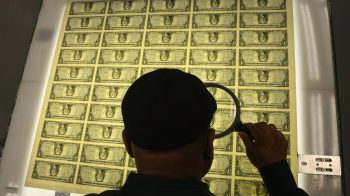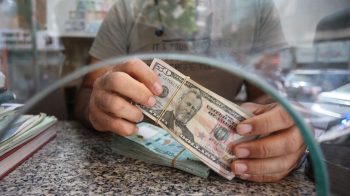Why the world is so bullish about the dollar
The U.S. dollar is at a four-year high, rising 7 percent since July. Other currencies, by contrast, have fallen — woe unto the euro (down 1.9 percent) and the New Zealand dollar (down 5.2 percent) according to Bloomberg Correlation-Weighted Indexes.
“Over the past few months it’s been a very strong story for the dollar,” says Michael Boutros, currency strategist with Daily FX. “We’re at multiyear highs here we haven’t seen since 2010.”
There are three primary causes for the dollar’s strength.
1. Recovery
“The U.S. economy is finally getting some traction,” says Win Thin, global head of emerging markets at Brown Brothers Harriman. Thin says people are buying dollars to take advantage of the U.S. recovery.
2. Yields
The dollar’s also being helped by a side effect of the recovery: changing Fed policy. The Federal Reserve is wrapping up the stimulus program that everyone calls Quantitative Easing (everyone except the Fed itself). That program kept the yield on government bonds and certain other securities low. As the program ends and yields are allowed to grow again, it should offer an opportunity for investors. It is, of course, an opportunity that one can take advantage of only in U.S. dollars, which is why dollars are so popular.
3. Interest rates
The Federal Reserve is also contemplating raising interest rates. Many suspect it will do so in the first half of 2015. Higher interest rates, again, create an opportunity to make more money and offer a lure to international investors.
By contrast, yields and rates around the world appear low and appear likely to remain low for some time. “The European Central Bank dragged its feet,” says Thin, in adopting unorthodox measures to stimulate its economy. “It’s belatedly addressing these issues now, and as a result the ECB may not raise rates until 2016 or even 2017.”
Money goes where money can grow, and economic and fiscal conditions make the U.S. the most fertile ground right now.
The appreciating dollar could offer relief to many developing countries, whose depreciating currencies are now making their exports look more attractive to consumers in the U.S. “Emerging markets have been complaining about stronger currencies — Brazil, Korea, for example.”
“In the U.S., a strengthening dollar makes goods produced in the United States more expensive abroad, and foreign goods cheaper in the United States,” says David Stockton, senior fellow at the Peterson Institute for International Economics. Cheaper imports will be welcomed by American consumers, but U.S. exporters will face difficulties.
“At the margin a stronger dollar could hurt exports, but it’s not as big a deal as [in] other economies around the world,” says Thin. “I think we could tolerate a stronger dollar in terms of economic impact much better than a country like, say, Korea or Taiwan could — exports are much more important to their economies.”
Stockton says the impact of more expensive exports and cheaper imports may be to stifle inflation just enough to make the Fed slow down any rate increases, which would in turn slow down the dollar’s rise. It would only slow it, however. All indicators suggest the dollar is in for a steady rise no matter what.
“Even if there were some crisis,” says Daily FX’s Boutros, and people started abandoning risky assets, “that’s still beneficial to the dollar,” since the safest place even in a crisis? Still the U.S. dollar.
There’s a lot happening in the world. Through it all, Marketplace is here for you.
You rely on Marketplace to break down the world’s events and tell you how it affects you in a fact-based, approachable way. We rely on your financial support to keep making that possible.
Your donation today powers the independent journalism that you rely on. For just $5/month, you can help sustain Marketplace so we can keep reporting on the things that matter to you.


















